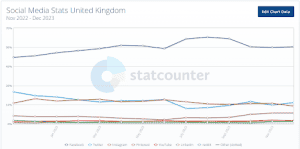Jan 2024
Under the influence, 5 Influencer marketing Trends for 2024
Written by Stevie Harding

Influencer marketing, love it or hate it, is here to stay.
The trend towards microbloggers was always the inevitable end game of a trend that started back in the 1960s when advertising moved away from the authoritative brand voice towards spokespeople and more humanised characters. Now every brand wants a relatable micro blogger with an appropriate audience as part of the marketing mix. With the potential market for social media almost completely saturated, this year businesses will need to be smarter if results are still expected to improve. Changes in segmentation and demographic focus are on the agenda, as businesses focus on converted sales in a harder market. User trends suggest that innovation is overdue, perhaps even necessary, as more consumers make the active choice to disengage from social media.


AI influencers will become more popular among young audiences.
While older generations value creators for their authenticity, to compete with the volume of content needed to leverage the algorithm, some influencers have already begun to leverage digital production companies to artificially produce content. AI influencers are able to generate content at a much more rapid pace that suits younger audiences. This trend will mostly benefit smaller creators, who are trying to rapidly scale upwards and compete with larger players in the space.
Segmentation will become more important with the smallest influencers creating the largest value
The virality of influencers and self-segmentation of most influencer audiences create the most positive value for SaaS businesses or those that can ship and scale their offering to meet new customers. For businesses that offer a geographically fixed product or those that cater to a niche audience, segmenting down to local influencers can offer the best bang for your buck. Similarly, having good taste in influencer selection helps amplify messaging. Blanket promotions that pop up across a segment highlight the obvious paid aspects of the promotion and undercut the value of the message.
Brands will reduce the amount of one-off promotions in favour of spokespeople and long-term advocates
Some companies such as Plarium Games, which develop RAID: Shadow Legends, have managed to make an in-joke around their shameless lack of exclusivity when using influencer marketing. As one of the first brands to make use of influencer marketing on YouTube, the company has sponsored almost every YouTube and Twitch creator. Good marketing doesn’t feel like selling, and smart segmentation can prevent this. It can be tempting to promote with several influencers across a single segment but most audiences will already follow several influencers in a given field or niche. If the entire group of influencers are all seen to be suddenly advocating for a company or product, alarm bells start to go off. Longer-running relationships with influencers lead to more genuine connections with influencers and their audiences. Athletic Greens, the nutritional supplement company rebranded as ‘AG1’ after IPO’ing before subsequently degrading the quality of the messaging and cheapening its previous relationships by advertising at scale with several influencers, rather than expanding existing relationships with noted ‘biohacking’ influencers Tim Ferris and Andrew Huberman. Comparably, Onnit has risen in popularity alongside its longest-running sponsee and controversial podcast host, Joe Rogan, in part contributing to its acquisition by Unilever in 2021.
Influencer marketing targeting working-age adults will increase
Influencer marketing got its start on social media and sites like YouTube which had demographics that skewed younger. However, the average TikTok user is between 18 and 24, and the ‘young professional’ influencer market is rapidly expanding to meet demand. Currently, many of these influencers do not feature extensive brand promotions, likely because a savvy company has not yet figured out how to leverage the channel effectively.
A new social media platform will change the current meta for influencer marketing


Social media has gotten stale. At the start of 2023, overall usage had fallen and user numbers have remained largely flat. While there have been some developments, Vertical video support was an overdue innovation, and algorithmic video servicing has been constantly refined since 2007 when YouTube launched. Despite format updates, the core offering on social media has not evolved significantly in recent years; it continues to be dominated by still images and snippets of text. Social media adoption is often a grassroots effort, and a new way to leverage communities could be a way forward for companies trying to build something Meta and Bytedance can’t clone. The recent growth of community-driven platforms like Polywork, Discord, Gas and Hive Social are signs of innovation to come.






